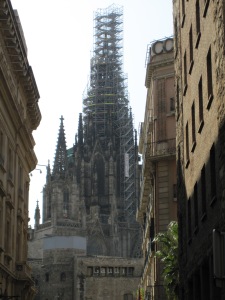 My time in Barcelona has just flown by. My internal compass has kicked in, at least for Bari Gotic and La Ribera with small parts of Eixample as well. Like a Gaudi design, there are few straight lines except for major streets (Carrer o Passeig). Generally, in only a few twists and turns, you can be back to a familiar avenida o placa, but you might not know how you got there!
My time in Barcelona has just flown by. My internal compass has kicked in, at least for Bari Gotic and La Ribera with small parts of Eixample as well. Like a Gaudi design, there are few straight lines except for major streets (Carrer o Passeig). Generally, in only a few twists and turns, you can be back to a familiar avenida o placa, but you might not know how you got there!
Today I started out on a hunt for the final Gaudi representation, Casa Calvet. I was not successful. This recommendation wasn’t on the DK “top 10” list, so I am assuming it is one of the more subtle and ubiquitous modernista buildings.
Back to the original list, I walked to the Palau de la Musica Catalana. At first I thought the guidebook must be mistaken. My approach from what was clearly the entrance to the building was a combination of new construction – creative, spiritually connected, but modern – and a glass encasement completely covering the visible part of the old building. I felt duped until I continued a walk around the building and discovered intact and in plain view the original ceramic tiles and carved stone decorative elements. It was an excellent way to close the Gaudi experience, even though I didn’t take the tour in favor of the Museu d’Historia de la Ciutat.
I almost ignored the Ciutat, but once again, Donald to the itinerary rescue. It is essential an archeological dig with a new building as its sombrero. By walking along a series of metal and plexiglass catwalks, it is possible to see many centuries of Barcelonan life. I think I may be getting some of the info mixed up, but I’m pretty sure the dig goes back to the 1st century. Barcelona was originally a settlement of the Iberian “culture” (their term) in 600 BC, and then a Roman settlement called Barcino, founded in 15-10 BC. This extensive complex includes living quarters, an “episcopal” cathedral and basilica, laundry and cloth dying facilities, shops (tabernas), and an enormous wine-making operation. I wasn’t aware that the origins of wine included adding honey, herbs, nuts, fruits and other natural foods to the wine. Maybe that’s the origin of the wine aroma wheel!? I was also confused by the term episcopal. Wasn’t that the Church of England many centuries later? Perhaps episcopal is generic for christian.
A short walk around the shops in the area, and it was time for lunch alfresco on a hot, sunny day. I wanted to try a rustic dish, butifara, described as a “farmhouse” sausage served with white canelli beans. It was outstanding, very salty unlike other dishes. I really wanted to try paella, since it is a regional specialty on Thursdays, but I didn’t dare take a chance of any mussels in the dish. What a terrible thing to be allergic to!
Next, the Picasso Museum. I’ve been to the Picasso Museum in Paris as well, and recently saw a Picasso/Cezanne exhibit in Aix-En-Provence. In fact, one of the pieces from Barcelona was in that show, “Natura Morta” or still life. This museum is devoted mostly to the time when Picasso’s family moved to Barcelona from Malaga when he was about 12 or 13, and other periods during his life when he lived in Barcelona. His schoolboy drawings and paintings show a talented budding artist, aspiring to portraiture and realism, moving at the turn of the century into modernism, and later to cubism and ceramics. One of his paintings, “Mujer con Mantilla,” echoes the ceramic shards used by Gaudi in his designs from the same period.
In the two minutes it took for me to walk from the museum to a deli to buy some water, my wallet was lifted from my bag. I have no idea when or how it happened. These bandits are good! The policia said that the library (book shop) area of the museum is particularly bad. I guess it’s because people are shuffling wallets and purchases, it’s easy to lessen caution. Fine time to learn this… And I had just written to Janie this morning that all was well. Gratefully all I lost was credit cards (now cancelled) and about €50, and I had enough $US to change for the taxi tomorrow. Room service isn’t exactly how I imagined my last night in Barcelona. I guess I will have to come back to see/do the things I missed.
Thanks for letting me “talk” to all of you throughout this journey. It’s been a joy to share the experience twice, once for real and again in thoughts/words!